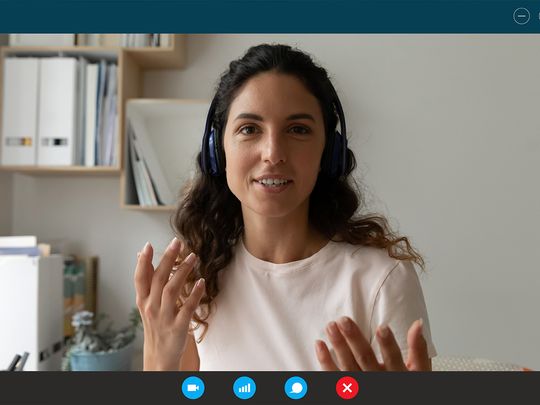
As it turns out, there’s a scientific reason for it. The truth is, our brain is far more active in actual interactions than online interactions.
As neurologists and neuro-scientists put it, seeing a person on screen isn’t able to “light up” the person’s brain the same way. Why so?
‘The brain is tuned to process facial cues’
Your phone’s face-processing method to unlock the device is helpful, but it pales in comparison to the brain’s ability to process facial recognition. However, the brain’s systems efficacy is far reduced, when it comes to online interactions.
There’s a reason why we tend to feel rather dull during online interactions. It’s more than just an exasperation: Our brain actually is tuned to process facial cues, explains Dubai-based neuropsychiatrist Madiha Khan. “The way we follow facial cues, or perceive the human face of a human, when we look at them is far more intense. The brain signaling is more intense in a real interaction, as compared to virtual. There is more engagement and we feel more involved. This is not just an emotional perception, but it is happening at a neurochemical level,” she says. “It’s really important to understand, is the significance of meeting people. There are nuances of facial expressions, and feeling each other’s vibes, which does not happen in online interactions.”

The way we follow facial cues, or perceive the human face of a human, when we look at them is different in personal interactions. The brain signaling is more intense in a real interaction, as compared to virtual. There is more engagement and we feel more involved...
There is coordinated neural activity that occurs when we meet someone in person, which also sees more reciprocal exchanges of social cues between them. For instance, there’s a joy in meeting an old friend in person that you haven’t seen before. You can get to hug them, joke and laugh with them, which leads to a release of dopamine, the happiness hormone in the brain. You can’t feel the same, when they’re just on the screen, even though they’re real.
In neurological terms, there is far more neural signaling in the dorsal-parietal region of the brain, compared to Zoom interactions. The different regions of the brain don’t “light up” on seeing someone on screen, as compared to meeting them in person, according to current research.
‘Suppressed neural signaling’

Recently, neuroscientists undertook intensive research to compare the brain’s activity during online interactions and in-person meetings. American neuroscientist Joy Hirsch from Yale monitored the brain activity of two people engaged in conversation, using sophisticated neuro-imaging tools. Functional near-infrared spectroscopy (fNIRS), eye trackers and electroencephalography (EEG) were used by Hirsch and the team to observe the eye and brain activity of people when they were talking to each other.
She observed there was complex neural activity in areas of the brain that govern social activity, according to Neuroscience News website. However, the people showed different neurological activity during a Zoom conversation. The brain activity showed theta oscillations, which are connected to effective face processing. Theta oscillations is a neural oscillation in the brain that underlies several aspects of cognition and behaviour, which includes learning and memory. The neural signaling was significantly suppressed in the online conversation, as compared to the real interactions.

During the facial interactions, Hirsch found that people had “increased” gaze time, which included increased pupil dilation. The pupils were generally larger for in-person interactions than for virtual faces, which suggest increased arousal and interest for seeing a person in real life.
Moreover, researchers from the same team found that there was an exchange of social cues during these in-person interactions. These social cues were missing during Zoom conversations; in fact there’s much less dynamic and natural interaction between people. There is also increased EEG activity when we talk to someone in person, which is characteristic of face-processing ability.
Information Courtesy: Mayo Clinic
“Online representations of faces, at least with current technology, do not have the same ‘privileged access’ to social neural circuitry in the brain that is typical of the real thing,” she told the scientific outlet. It shows how crucial live, face-to-face interactions are for our natural social behaviours.
Earlier research has also showed that online interactions suppress the creative flow. US-based Columbia University researchers in 2020 discovered that when workers brainstorm face-to-face, they produce more ideas and ideas that are more creative, compared with when on a video call.
‘The intense scanning by neurons’
Most of us zone out during Zoom calls, for good reason.
The brain requires a face recognition process, explains Manio Van Maravic, neurologist based at the German Neuroscience Center in Dubai. There are several areas of the brain that are attributed to the function of face-processing, he says. “Mainly, the human visual brain system with the occipital lobe, lateral temporal lobe and the so-called fusiform face area, is specialised for face recognition.”
The truth is in the details, as he elaborates. When we talk to someone, there is an “intense” scanning that is taking place by our neurons. “As the visual information gets more details, the stimulation of the neurons is more intense, and corresponds to different areas of the brain,” he says.

Although the zoom – systems allow a high pixel resolution, the eye-to eye interaction in zoom-like conferences is compromised or distorted, the focussing time of the partner’s eyes reduced...
However, during virtual communication, neuronal stimulation is significantly less. The detection of the facial micromovements may reduce with virtual online format, he says. There are several theories behind this. One suggests that the dynamic social cues that are typically exchanging by interacting with people in person, are not acquired or exchanged during the online interactions. As there is less and shorter face scanning that takes place, less information is conveyed to the brain. “And so, there is reduced eye-scanning activity, when you see a face on a screen,” explains Maravic.
Moreover, even though zoom interactions can have ‘high pixel’ resolutions, the eye-to-eye interaction in the zoom-like conferences is compromised and distorted. As a result, the focusing time of the person’s eyes are reduced, says Maravic. “So, these ongoing studies show that virtual communication is characterised by reduced neuronal activity, in the visual communication system. This has an impact on social interaction, concentration and work efficiency,” he says. As a result, sometimes we can feel dull, and our ability to think creatively is greatly reduced.









